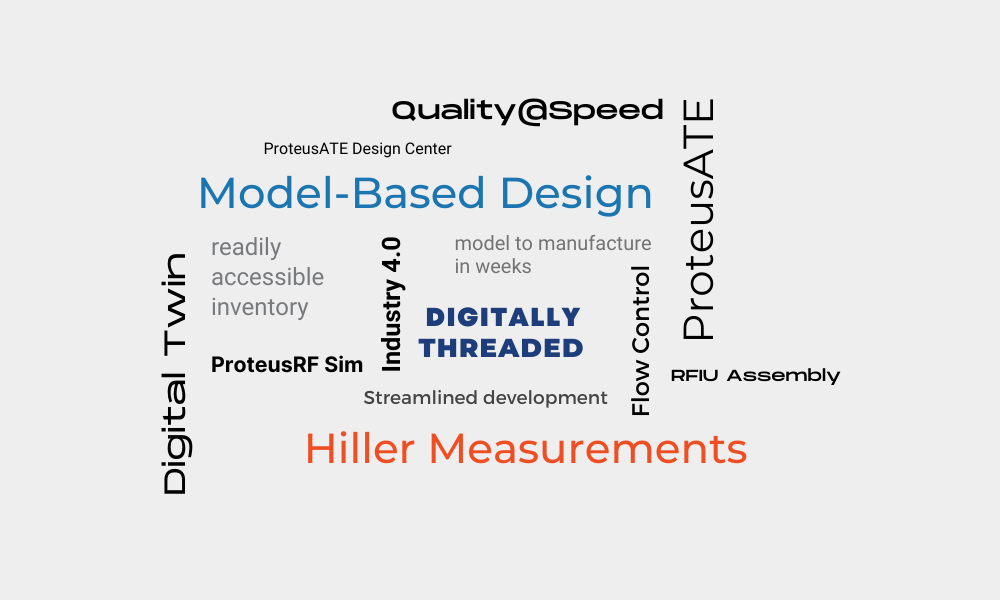Model-Based Design: Hype? Or the Future…

Like most organizations, public or private, Hiller Measurements is driven to produce more value, faster and leaner than ever before, while improving overall quality. How do you do that? For many, the answer seems to be “you can’t,” which becomes the assumed reality until a single organization proves otherwise.
We’re not waiting for someone else to disrupt our industry.
We live in an extraordinary time of challenge and need for re-envisioning how work is done. As Hiller strives to bring disruptive value to our markets, we’ve invested heavily in moving to a model-based workflow, designed to enable mass customization with improvements in quality and/or cycle times by a factor of 10 or more. We’ve started to deliver on this vision with platforms under the “ProteusATE” banner and have engaged our markets explaining the ethos behind what we are able to achieve with a model-based approach.
As we’ve developed our vision, we’ve heard other companies use terms such as “Digital Thread” or “Digital Twin” without defining what they mean. Similarly, there’s plenty of grandiose vision of what’s possible with little about what is realistic when it comes to model-based design. This has created substantial confusion and a fair bit of skepticism as to what model-based workflows are capable of. Thus, the following series of blogs is intended to clarify much of this confusion from the perspective of Hiller’s own experience developing model-based workflows.
Model-Based Design Definition and Benefits
As engineering design professionals, what is the final “product” of our efforts, prior to manufacturing the design itself? Historically, this would be documentation describing the design. At Hiller, this includes CAD drawings of a variety of types, source and executable code, status reports, Bills of Material, work orders, work breakdown structures, Preliminary and Critical Design Review packages, PowerPoint presentations, proposals, etc. etc. etc. When you step back, it’s an enormous stack of documents.
Problematically, documentation is written in disparate environments and saved in flat file structures, or at best, rudimentary indented file storage set ups. With this approach and structure, making a change to a design in one area necessitates a focused effort to consider the effects on all other areas, followed up with updates and modifications to all necessary design artifacts across a particular design’s documentation. Managing engineering change notices (ECN) often becomes one of the more costly parts of any project.
We’ve long known the use of models has enormous benefits to bring a design to reality. Think a clay model of a new car, a 3D model of a part designed in CAD, or an architect’s hand-built scale model of a new building. Viewing the holistic representation of a design, rather than through the documents that defined it, brings beneficial fidelity to the nature of a design. So, one could say model-based design has been around for decades, which is true.
Increasing complexity of designs, with multiple required disciplines, aggravated by accelerated design iteration requirements, create an extraordinary burden to organize and maintain design fidelity across the design lifecycle. Modern model-based design approaches address these levels of complexity where clay, CAD, and carboard fail to.
At its core, modern model-based design philosophy is built around this concept: replace documentation as the fundamental output of engineering design with a holistic, interconnected model describing the design.
When successfully executed, a model becomes the core “source of truth” for the design, rather than documentation. Changes applied to the model, ripple across the entire design in a near automated fashion. Documentation is generated from or is reflected by the model, rather than as the primary design artifact.
Models lend themselves to simulation and test. Documentation typically does not. Once the philosophy and foundation for model-based approaches have been developed and accepted, schedules shorten with accelerated design iterations which in turn reduce cost burdens, often with enormous positive affect.
The key is the “holistic, interconnected” development of a model approach. In upcoming blogs, we will explore this more in-depth in discussions on the definition, use, and benefits of developing a “Single Source of Truth,” “Digital Thread,” and “Digital Twin,” as well as the nuances between model-based design and model-based system engineering.
When effectively developed, a model-based design offers an enormous improvement in cost reduction and schedule acceleration by removing otherwise manual and burdensome overhead a documentation-based approach relies upon. We’ve proven this to be true at Hiller Measurements.
Want to discuss the details of how we execute Model-Based Design at Hiller? Schedule a time and we’ll talk more.

